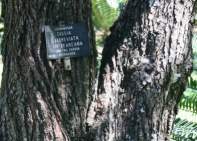Cassia abbreviata subsp. beareana
Cassia abbreviata Oliv. subsp. beareana (Holmes) Brenan
Family: Fabaceae
Common names: long-tail cassia, sjambok pod, wild senna (Eng.); sjambokpeul, peulboom, peulbos, boontjieboom (Afr.), molepelepe, monêpênêpê (Tw), muboma, mulambivhu, muluma-nama, muvhonelathangu (V)
SA Tree No: 212
Introduction
The long-tail cassia is ideal for small to medium-sized gardens where it will attract attention with both its beautiful deep yellow, sweetly scented flowers and its long seed pods.

Description
Description
Cassia abbreviata subsp. beareana is a small to medium-sized deciduous tree up to 7 m high. Its slender to medium-broad trunk is covered in bark that ranges from dark brown to grey and black. In old trees the bark is often deeply furrowed.

The leaves, which appear lightly drooping, are compound (one leaf made up of smaller leaflets), bright green when young and fade to a darker green when older.

The flowers, which can be seen from August to October, are deep yellow and appear clustered at the ends of the branches. They are sweetly scented. The pods appear soon after the flowers, are up to 80 mm long and cylindrical in shape. They ripen from a light green to a dark brown. The pods may take up to a year to ripen.

Conservation Status
Status
Least Concern (LC).
Distribution and habitat
Distribution description
The long-tail cassia is found naturally in low altitude arid bushveld, open woodland and at times on riverbanks. Where natural distribution is concerned it is widespread in Limpopo Province, Mpumalanga and Swaziland, in East Africa and up to Somalia.
Derivation of name and historical aspects
History
The genus name Cassia is derived from the Greek kasian. The species name abbreviata means shortened, and the subspecies beareana was named after Dr O'Sullivan Beare from the London Pharmaceutical Society who apparently found that a root extract from this plant could be used to cure blackwater fever. There are about 30 Cassia species worldwide, but this is the only one found naturally in South Africa, although others are cultivated as garden plants.
Ecology
Ecology
This tree is popular with both animals and humans. Various birds from our indigenous parrot species to the Go-away Bird eat the fruit pulp and seeds. Animals such as Nyala, Giraffe and Kudu browse the leaves. Elephants are also said to eat the leaves and the young branches of the tree.
Uses
Use
Various parts of the tree are used in traditional medicine for treating everything from blackwater fever, headache, toothache and stomachache to using it as a natural abortion agent.
An infusion is made from the root and drunk as an aphrodisiac. The seed is known to be used as a tonic. The root is used for the treatment of toothache. And for the treatment of headaches, the smoke from smouldering twigs can be inhaled to bring relief.
In addition the tree is also seen as a very useful ornamental subject in gardens.
Growing Cassia abbreviata subsp. beareana
Grow
This deciduous tree with its beautiful ornamental flowers, is drought resistant, but frost tender. It requires little water and should be planted in full sun.
The long-tail cassia is relatively slow growing but grows easily from seed. After harvesting the seed, place it in warm water and leave it to soak overnight before sowing it the next day.
It is important to protect young plants from frost and do not overwater the tree in winter, as it will not flower as prolifically in springtime.
References
- Joffe, P. 2001. Creative gardening with indigenous plants: a South African guide. Briza Publications, Pretoria.
- Schmidt, S., Lotter, M. & McCleland, W. 2002. Trees and shrubs of Mpumalanaga and the Kruger National Park. Jacana, Johannesburg.
- Smith, C.A. 1966. Common names of South African plants. Memoirs of the Botanical Survey of South Africa No. 35.
- 1997. SAPPI Tree spotting: Lowveld. Tree identification made easy. Jacana, Johannesburg.
- Van Wyk, B.-E. & Gericke, N. 2000. People's plants: a guide to useful plants of southern Africa. Briza Publications, Pretoria.
Credits
Lou-Nita Le Roux
Lowveld National Botanical Garden
March 2008
Plant Attributes:
Plant Type: Tree
SA Distribution: Limpopo, Mpumalanga
Soil type: Sandy, Loam
Flowering season: Spring
PH: Acid, Neutral
Flower colour: Yellow
Aspect: Full Sun
Gardening skill: Average
Special Features:
Horticultural zones








Rate this article
Article well written and informative
Rate this plant
Is this an interesting plant?
Login to add your Comment
Back to topNot registered yet? Click here to register.